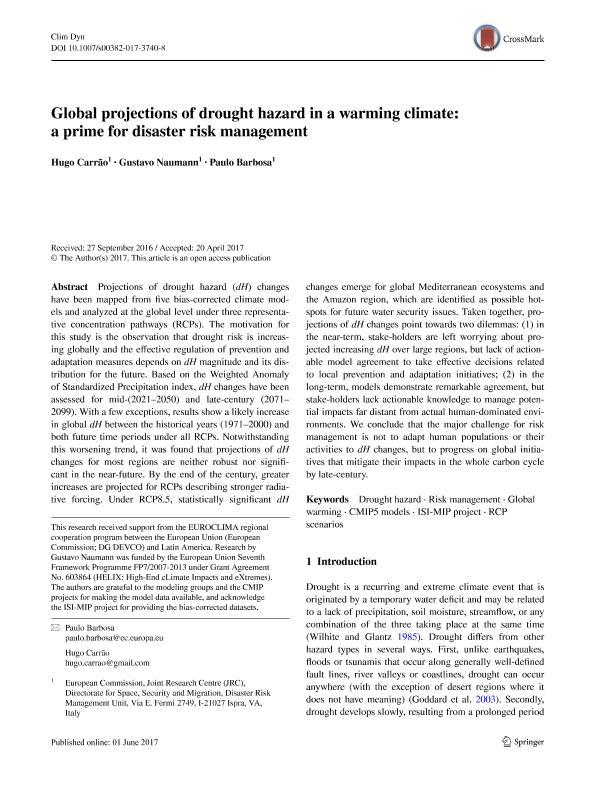Mostrar el registro sencillo del ítem
dc.contributor.author
Carrão, Hugo
dc.contributor.author
Naumann, Gustavo

dc.contributor.author
Barbosa, Paulo
dc.date.available
2018-09-18T20:15:15Z
dc.date.issued
2018-03
dc.identifier.citation
Carrão, Hugo; Naumann, Gustavo; Barbosa, Paulo; Global projections of drought hazard in a warming climate: a prime for disaster risk management; Springer; Climate Dynamics; 50; 5-6; 3-2018; 2137-2155
dc.identifier.issn
0930-7575
dc.identifier.uri
http://hdl.handle.net/11336/60154
dc.description.abstract
Projections of drought hazard (dH) changes have been mapped from five bias-corrected climate models and analyzed at the global level under three representative concentration pathways (RCPs). The motivation for this study is the observation that drought risk is increasing globally and the effective regulation of prevention and adaptation measures depends on dH magnitude and its distribution for the future. Based on the Weighted Anomaly of Standardized Precipitation index, dH changes have been assessed for mid-(2021–2050) and late-century (2071–2099). With a few exceptions, results show a likely increase in global dH between the historical years (1971–2000) and both future time periods under all RCPs. Notwithstanding this worsening trend, it was found that projections of dH changes for most regions are neither robust nor significant in the near-future. By the end of the century, greater increases are projected for RCPs describing stronger radiative forcing. Under RCP8.5, statistically significant dH changes emerge for global Mediterranean ecosystems and the Amazon region, which are identified as possible hotspots for future water security issues. Taken together, projections of dH changes point towards two dilemmas: (1) in the near-term, stake-holders are left worrying about projected increasing dH over large regions, but lack of actionable model agreement to take effective decisions related to local prevention and adaptation initiatives; (2) in the long-term, models demonstrate remarkable agreement, but stake-holders lack actionable knowledge to manage potential impacts far distant from actual human-dominated environments. We conclude that the major challenge for risk management is not to adapt human populations or their activities to dH changes, but to progress on global initiatives that mitigate their impacts in the whole carbon cycle by late-century.
dc.format
application/pdf
dc.language.iso
eng
dc.publisher
Springer

dc.rights
info:eu-repo/semantics/openAccess
dc.rights.uri
https://creativecommons.org/licenses/by-nc-sa/2.5/ar/
dc.subject
Cmip5 Models
dc.subject
Drought Hazard
dc.subject
Global Warming
dc.subject
Isi-Mip Project
dc.subject
Rcp Scenarios
dc.subject
Risk Management
dc.subject.classification
Investigación Climatológica

dc.subject.classification
Ciencias de la Tierra y relacionadas con el Medio Ambiente

dc.subject.classification
CIENCIAS NATURALES Y EXACTAS

dc.title
Global projections of drought hazard in a warming climate: a prime for disaster risk management
dc.type
info:eu-repo/semantics/article
dc.type
info:ar-repo/semantics/artículo
dc.type
info:eu-repo/semantics/publishedVersion
dc.date.updated
2018-09-17T19:27:44Z
dc.identifier.eissn
1432-0894
dc.journal.volume
50
dc.journal.number
5-6
dc.journal.pagination
2137-2155
dc.journal.pais
Alemania

dc.journal.ciudad
Berlin
dc.description.fil
Fil: Carrão, Hugo. European Commission, Joint Research Centre; Italia
dc.description.fil
Fil: Naumann, Gustavo. European Commission, Joint Research Centre; Italia. Consejo Nacional de Investigaciones Científicas y Técnicas; Argentina
dc.description.fil
Fil: Barbosa, Paulo. European Commission, Joint Research Centre; Italia
dc.journal.title
Climate Dynamics

dc.relation.alternativeid
info:eu-repo/semantics/altIdentifier/doi/http://dx.doi.org/10.1007/s00382-017-3740-8
dc.relation.alternativeid
info:eu-repo/semantics/altIdentifier/url/https://link.springer.com/article/10.1007%2Fs00382-017-3740-8
Archivos asociados
